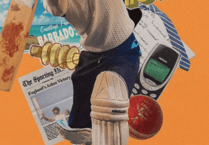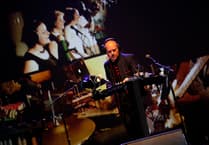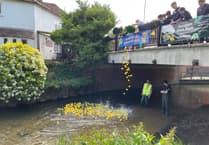For most of us Hallowe’en is a bit of fun, a time for children and sometimes adults to dress up as ghosts, witches and vampires and have a party. For young children to go to door to door “trick or treating”often with a parent in tow and collect sweets from willing participants, writes local historian and East Hampshire councillor Adam Carew.
Yet this was not always the way. Some understandingly deplore the trick element which seems far less common these days and decry it all as a marketing ploy imported from America.
It is certainly a US import, yet there are parts of Britain where All Hallows Eve has long been if not exactly celebrated certainly marked and remembered. The US version of Hallowe’en, imported here in the late-20th and early-21st century was actually imported to America by immigrants from Britain in the 19th century especially those from Scotland and Ireland and perhaps from other countries too.
My parents who grew up in the 1920s and ‘30s never celebrated Hallowe’en as children and although we had jack-o’-lanterns and some people dressed up as witches on Hallowe’en, when I was a growing up in Whitehill & Bordon in the 1970s there was more interest in Guy Fawkes and Bonfire Night. Even ‘Penny for the Guy’ was still being done on Chalet Hill!
The term Hallowe’en is derived from the religious (Christian) festival of All Hallows Eve or Even (meaning evening, ie the night before, in the same way as we use the term Christmas Eve), from whence we get Hallowe’en aka All Souls Eve/Even which precedes All Souls Day in the Christian calendar and also All Saints Day, which is probably more of a Roman Catholic than protestant thing but is retained by Anglican Faith/Church of England who believe in existence of Saints but rarely use them to intercede on our behalf between us and God.
I certainly remember our local vicar at Blackmoor, Reverend Richard Inkpen, speaking out with real concern in the 1970s and early 80s from the pulpit, in the parish magazine and local press, condemning the creeping celebration of Hallowe’en for the dangers of witchcraft, contacting the dead and the use of Ouija boards.
We never had ‘trick or treat’ as children and although we made jack-o’-lanterns, there were no pumpkins then so we had to use swedes, turnips or marrows. My mother, who was a devout Christian, set up and ran the local girl guides and they used to celebrate Hallowe’en by dressing up and having competitions for the best costume and jack-o’-lantern and playing games like apple bobbing, where you have to catch an apple in your mouth out of a tub of water.
It was not until the mid-1980s when I was in my mid-teens that we started getting visits from small gangs of children and teens without parents demanding money or treats. There was genuine concern at the time as a minority of people were getting their cars scratched, tyres let down and flower beds trashed, even stones thrown at windows if they were given nothing or didn’t like their treat (most people then did not go out and buy tubs of sweets for this purpose and kids took what they were given – I don’t think apples ever went down very well). Fortunately the spate of reprisals only seemed to last a few years.
When trick or treating came over here it was certainly seen by many as demanding money with menaces. Yet despite being a US import its origins can be traced to much older traditions of perambulatory customs that were once common in Britain around this time of year, ie autumn to winter, where villagers would dress up go from house to house and pub to pub performing songs and plays, playing instruments or in the case of Wassailing just making an incredible din by banging pots and pans in return for food and drink or drinking donations.
These folk customs were performed this time of year when seasonal work associated with agriculture had ended with the harvest, work and food was scarce and times were particularly harsh for the rural poor. In a face to face society they can be seen as a reminder from the poorer or working sections of the community to the wealthy rate payers and landed gentry or “squirearchy” of their patriarchal responsibilities to helping the poor of the community when times were hard (not that they all did).
Many of these customs are performed later in the year and are associated with Christmas, eg mummering, carolling (carol singers), thomassing, wassailing and the vile practice of wren hunting (which now illegal, can only be performed with a wooden bird). Many of these are Mediaeval customs that were still prevalent in Victorian and Edwardian times upto the Second World War, after which they pretty much died out only to revived again with interest in folk in the late-1960s and early-1970s.
Carolling being a more religious affair largely stems from when gallery choirs and village bands with their instruments were thrown out of churches by Oxbridge educated vicars and replaced by organs. Other practices eg Wassailing and plough stotting (plough boys) and rapper Morris, which was celebrated at New Year, have their roots in the Pagan past, the latter two involving ritual execution.
Yet in pockets of the UK especially in Scotland, Wales and parts of West Country, Hallowe’en has always been celebrated, long before the American import, and is part of the Celtic tradition.
The Hallowe’en celebrations here are based on the Celtic festival of Samhain which literally means “the end of summer” and the start of the darker half of the year, where crops have all been gathered in, plants are dying, the climate is colder, the days shorter and darker and food more scarce.
Samhain is a time when ancestors and the souls of the dead are supposed to pass close to the earth and is exactly why people used to burn jack-o’-lanterns (pumpkin heads) with their scary faces to ward away witchcraft and restless spirits of the dead. These were used specifically at this time of year in addition to any existing witch marks and glyphs of warding that may have been used over any opening a witch or evil spirit could enter the house, doors, windows and especially fire places.
We had witch marks on a beam over the hearth (fire place ) in a cottage we lived in. Witch bottles containing urine, iron nails and sometimes hair are often found in old thatch or below the floor in old houses for the same purpose of warding away witchcraft and wandering souls. Galleting or 9/10 penny nails which features as a vernacular decoration on many older cottages in the area, eg Selborne, uses our local ferruginous sandstone, aka iron stone or forest stone, and was said to ward away witches.
Sometimes elder, hazel, or holy and rowan trees were planted close to cottage doors to keep away witches: Elder is associated with the protective tree spirit of the Elder Mother, hazel with the Hind Ettin whilst holy, yew and rowan with their red berries, associated with the blood of Christ, is associated with Christ. Rowan crosses were also common above the lintels and thresholds in Scotland for the same purpose. So if you see any of these old trees by a front door of an old cottage you will now know why!
During winter it was common to have fire festival, hence our tradition of bonfires, which either means “bon” or “good” fire from the Norman French or is a corruption of “bone fire”, which may be a reference to the 4,000 year old Bronze Age practice of funeral pyres and collecting the ashes, which in the case of high status burial (clan chiefs and their familial groups) were then buried under mounds called round barrows, like the two we have outside Whitehill Village Hall.
Sometimes there are additional burial added in and between these mounds. Whitehill parish actually has one of the highest concentrations of round barrows anywhere in Britain so along with the dark pools in which nationally important Bronze Age weapon hoards were thrown as votive offerings. Four millennia ago our area would have been a very sacred place indeed!
It is highly likely then that the practice of having a bonfire to celebrate the capture and execution of Guy Fawkes and saving of King James I and Parliament from being blown up in 1605 was merely connected to existing community bonfires held this time of year – an echo of winter fire festivals from our pagan past.
In the late-90s and new millennium, there was a definite push by Tony Blair’s New Labour Government to promote Hallowe’en at the expense of Guy Fawkes Night the following weekend. This is because it did not fit in with their multicultural agenda and by more politically correct/woke sections of the Labour Party and was still seen as divisive and sectarian.
In reality, most people these days just celebrate the fireworks and call it firework night or bonfire night. Few people still burn “a guy”, Guy Fawkes in image, although I have heard that controversial characters, hate figures such as Donald Trump have been burnt more recently.
Yet the truth is that the Gun Powder Plot was a Roman Catholic Plot by a minority of fanatics to, as Guy Fawkes put it, “blow King James back to Scotland” and Parliament with it.
Our family always celebrated bonfire night and had fireworks and although we used to make and burn “a guy” in the 1970s, we never associated this with anything anti-Catholic, not least as my parents were ecumenical Christians and my brother in law is Roman Catholic. I am not even sure that many people today think of Guy Fawkes as a Roman Catholic mercenary, I have even seen a t-shirt with his image the legend reads “Guy Fawkes – the only person to enter Parliament with honest intentions”. Funny if a bit harsh.
Yet there are certain areas such as Lewes in East Sussex, where there are were and may still be sectarian overtones of their amazing bonfire celebrations.
Whether Blair as a Christian and eventual Catholic convert was aware that promoting Hallowe’en to get rid of potentially sectarian Guy Fawkes Night would still be seen by sections of the Christian Church including Anglicans, the Free Church and Catholics as promoting dangerous contact with the dead, superstition and witchcraft I am not sure.
It is worth saying that today there are many practitioners of Paganism, modern witchcraft, eg Wiccans, for whom Hallowe’en or rather Samhain will be an important festival.
Vicar of Blackmoor and Whitehill, the Rev Inkpen, who was Anglican/CofE, not only condemned Hallowe’en but also burning of Guy Fawkes or indeed anybody in image as it was a horrific reminder of public executions. Gun powder plotters Guy Fawkes, Thomas Wintour, Ambrose Rookwood and Robert Keyes were not actually burnt at the stake. They suffered the worst possible punishment reserved for traitors, being hung, drawn and quartered (although this would have involved castration and burning of their private parts and entrails in front of them and the gallows crowd).
In England at least, burning at the stake was only reserved for heretics and more associated with the religious genocide of Bloody Mary and Elizabeth I, immediately before the reign of James I. It was not even used against those accused of witch craft in England who were instead “swam” or “hanged”. Only in Scotland and mostly in Northern Europe eg Germany was fire used. The concept behind this was holy fire to burn something clean as a way of destroying witchcraft or evil.
Needless to say some people are still concerned about imagery concerning witchcraft, ghosts and ghouls as the association with black magic. But for most people Hallowe’en is seen a chance for children to dress up, hear scary stories and have a bit of fun. Pubs run halloween themes and have costume competitions for adults. Many villages organise a map so children go in groups with their parents only to houses who wish to participate in trick or treat by providing sweets.
With the decline of carol singing, it is perhaps one of the few perambulatory (walking from house to house) customs now practiced in England outside folk and Morris circles. What ever your views on Hallowe’en or Bonfire Night, stay safe and have fun.





Comments
This article has no comments yet. Be the first to leave a comment.